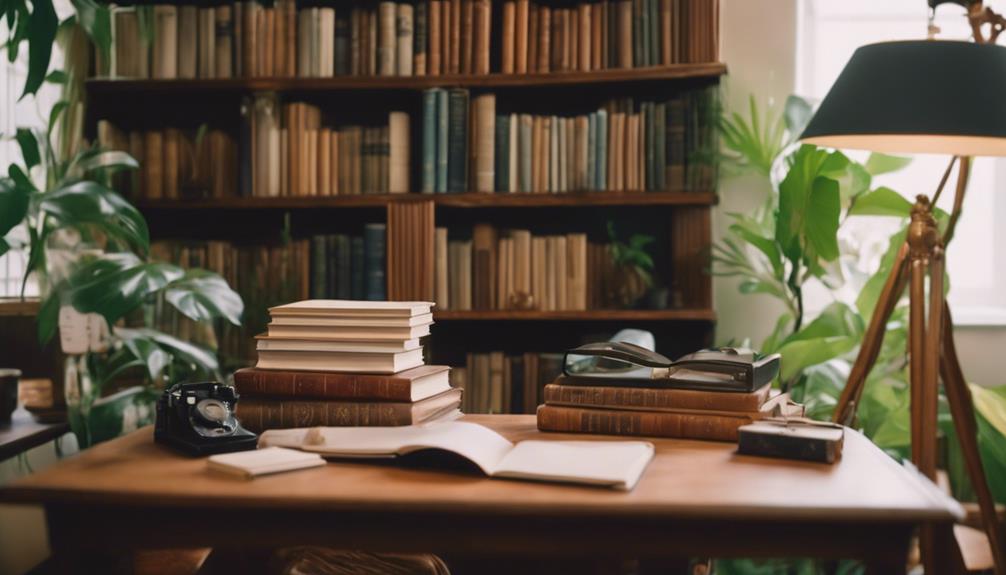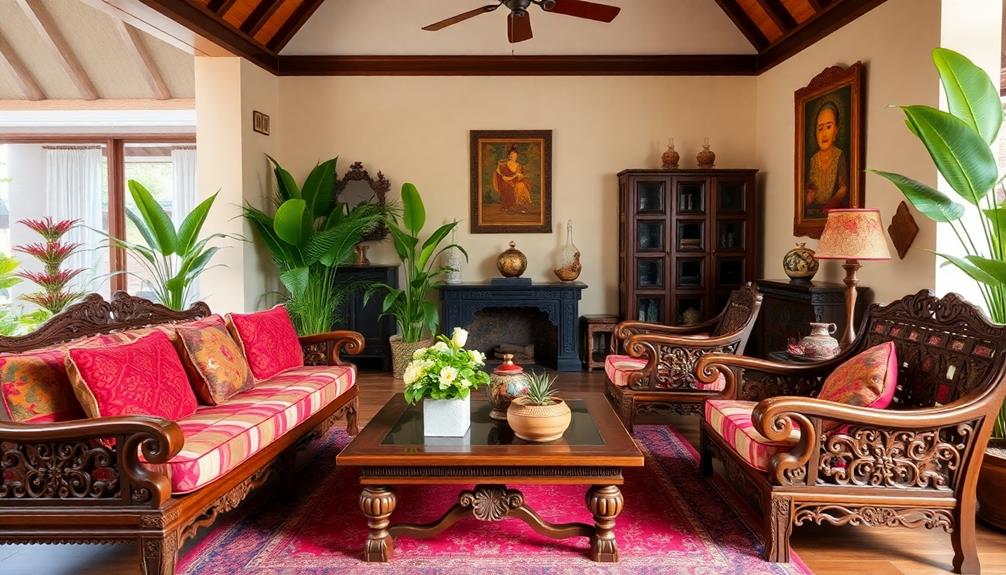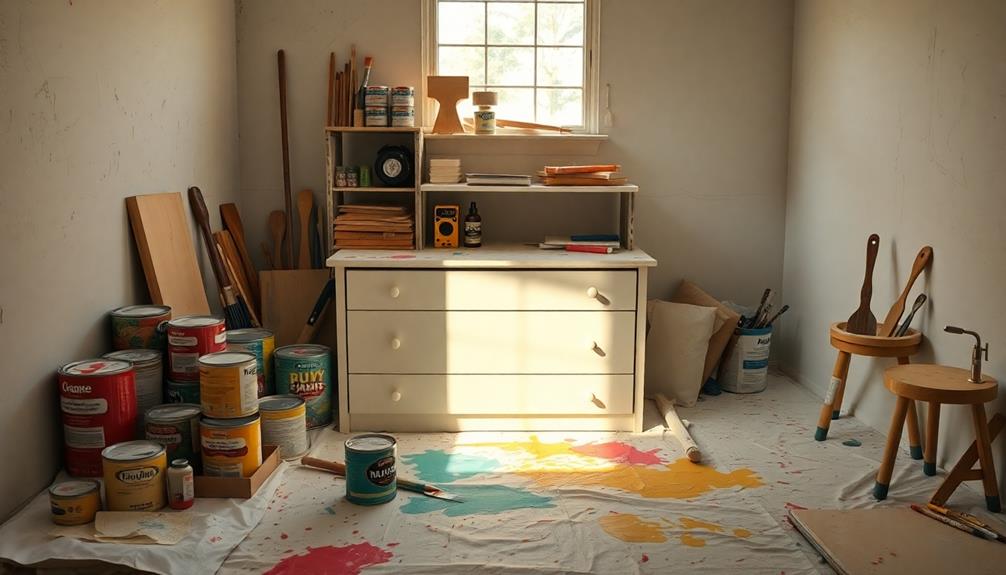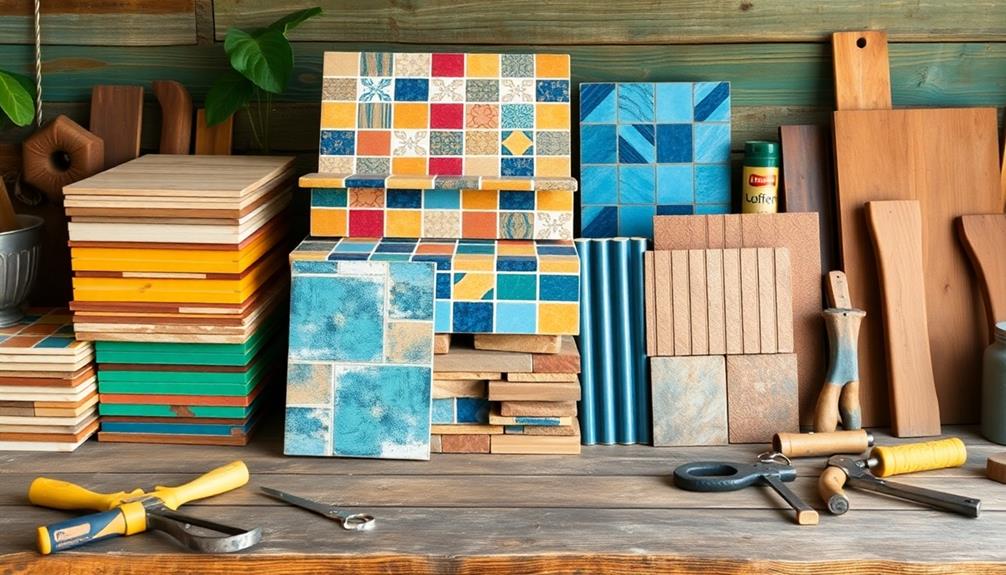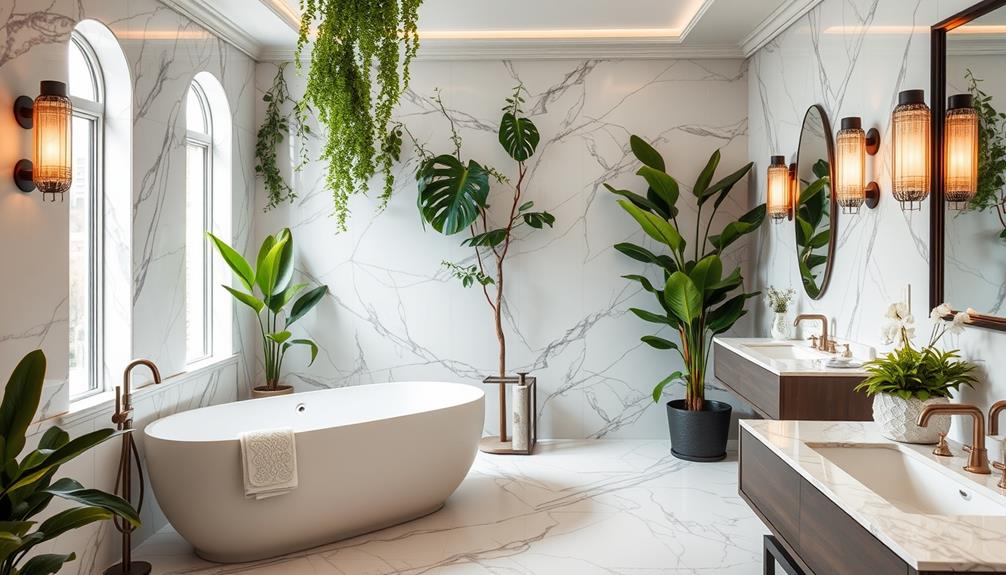Light Academia room decor sets a lively, intellectual ambiance that captivates everyone. Begin with gentle, subdued shades and incorporate vintage furniture such as a wooden writing desk and a cozy chair for unwinding. Mix in antique pieces like a brass lamp or a sophisticated globe bar cart to elevate the aesthetic. Layer textures with snug throws and delightful floral prints for coziness and charm. Allow natural light to filter in through sheer curtains, while hanging framed botanical prints as captivating centerpieces. There are many more ideas to discover to achieve that ideal vibe, so stay tuned for more inspiration!
Key Elements
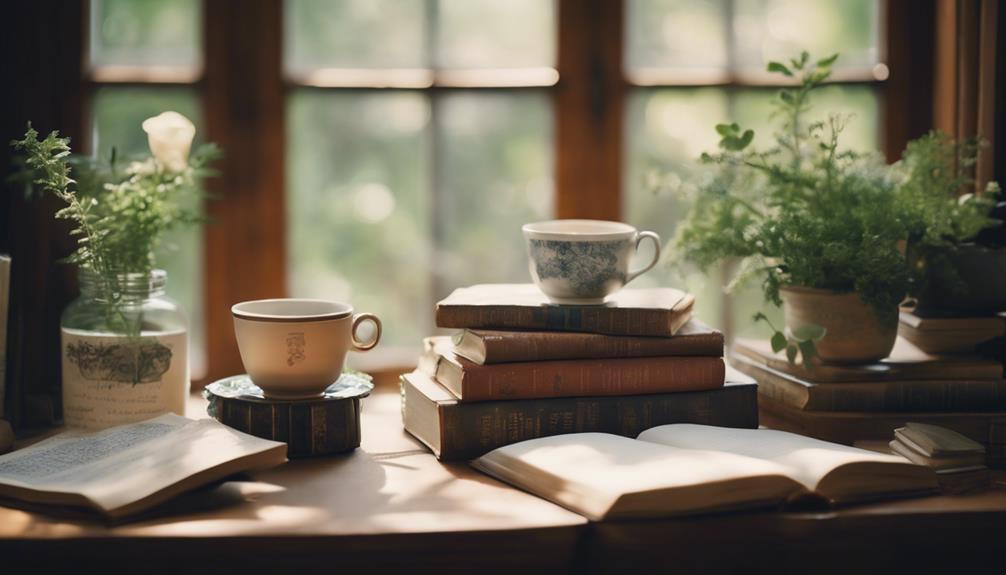
When you think about Light Academia room decor, consider the color scheme, materials, and textures that define this aesthetic.
Soft, muted tones paired with natural materials create an inviting and serene environment.
Additionally, incorporating varied textures can add depth and warmth to your space, enhancing the overall cozy feel.
Color Scheme
The Light Academia color scheme invites you into a world of soft, muted tones like cream and beige, creating a warm and scholarly atmosphere that's both calming and elegant. This carefully curated color palette features light shades paired with neutral tones to maintain balance and avoid overwhelming your space.
By incorporating these soft tones, you'll foster a serene environment perfect for study and reflection.
To enhance the aesthetic, consider adding accents in pastel colors like powder blue, baby pink, or sage green. These gentle hues bring a feminine touch and complement the overall lightness of the decor. Gold accents can also elevate the elegance of your room, adding sophistication without detracting from the calming vibe.
Maximizing natural light is essential in achieving the Light Academia look. Open windows will allow warm sunlight to flood the space, further enhancing the light color scheme.
Basically, the combination of these elements creates a harmonious and inviting atmosphere where you can immerse yourself in creativity and knowledge. Embrace the beauty of this color scheme, and let it inspire your decor choices!
Materials
Embracing light, airy materials like cotton, linen, and natural wood creates a cozy atmosphere that invites relaxation and learning in your Light Academia space.
To enhance the vintage charm of your decor, consider incorporating iconic patterns such as floral prints, plaids, or gingham in your textiles. These designs not only add sophistication but also evoke a sense of nostalgia.
Integrate antique books and vintage globes into your decor to foster a love for literature and exploration. They serve as both beautiful accents and conversation starters.
To bring a touch of nature indoors, add potted plants and dried flowers, which infuse freshness and tranquility into the environment.
Soft finishes, achieved through materials like brass or gold accents, create an elegant ambiance that complements warm lighting. This combination evokes the charm of old collegiate life, making your space feel inviting and scholarly.
Textures
Textures play an essential role in shaping the inviting ambiance of your Light Academia space, blending comfort with sophistication. To truly embody the Light Academia style, focus on using light, airy materials like cotton and linen. These fabrics create a cozy atmosphere, inviting you to curl up with a book or enjoy a quiet moment.
Layering different textures is key. Combine soft throws, ruffled pillow covers, and vintage quilts to enhance the tactile experience and warmth of your room. Incorporate iconic patterns like plaids and florals to add sophistication and romantic charm.
Don't forget to bring in natural elements. Plants and dried flowers not only contribute organic texture but also inject freshness into your decor, reinforcing that scholarly and tranquil vibe. Soft finishes should dominate—avoid harsh materials that disrupt the inviting feel.
Essential Fixtures and Furniture
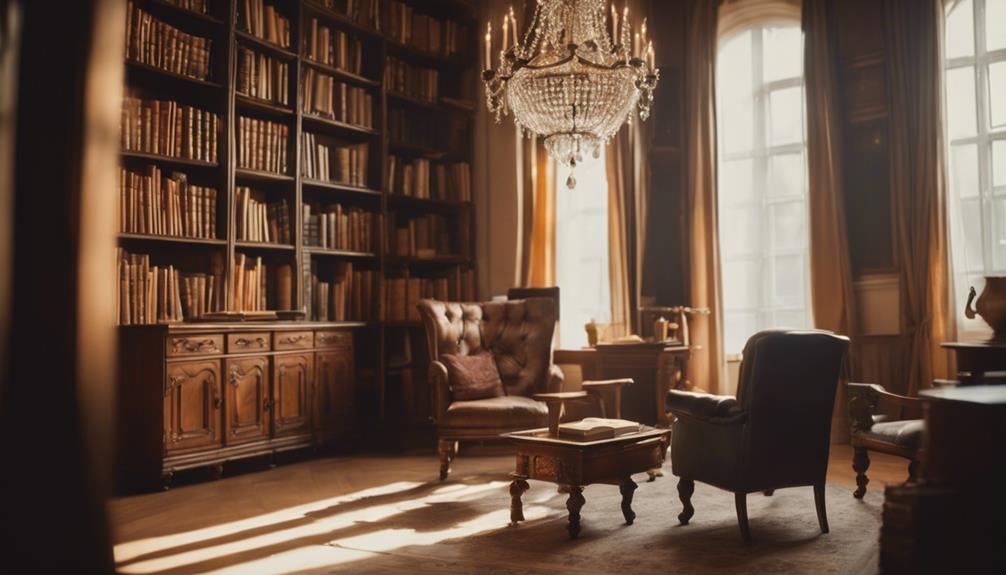
When setting up your Light Academia space, think about incorporating a vintage wooden writing desk as your centerpiece.
Pair it with an antique brass table lamp for warm lighting and an antique globe bar cart to add a touch of sophistication.
These essential fixtures not only enhance your decor but also create an inspiring environment for study and reflection.
Vintage Wooden Writing Desk
A vintage wooden writing desk stands as the centerpiece of your Light Academia room, merging functionality with timeless elegance. Crafted from rich materials like oak or walnut, these desks often feature intricate detailing that enhances their antique charm. Position your wooden desk near a window to bathe it in natural light, creating an inviting atmosphere that encourages productivity and creativity.
To elevate your light academia room decor, adorn your desk with vintage accessories. A vintage style vase filled with fresh flowers can add a touch of life, while calligraphy tools inspire your writing endeavors. Consider placing antique items, like gilded mirrors or old books, on the desk to showcase your penchant for history and aesthetics.
Complement your writing desk with a comfortable chair that reflects vintage styling, transforming the space into a cozy reading nook. This corner will be perfect for diving into literature or jotting down thoughts in your journal.
With a vintage wooden writing desk, you create a harmonious blend of beauty and purpose, embodying the essence of learning and self-discovery in your personal sanctuary.
Antique Brass Table Lamp
An antique brass table lamp instantly elevates your light academia room, adding a sophisticated touch that beautifully complements the vintage decor. With its warm metallic finish and intricate detailing, this lamp resonates with the nostalgic allure of classic styles, making it perfect for your scholarly space.
Positioning an antique brass table lamp on your vintage writing desk or bookshelves not only enhances the academic ambiance but also provides essential lighting for your reading and writing tasks. The soft warm light emitted by the lamp creates an inviting atmosphere, promoting relaxation and focus during study sessions.
When selecting your lamp, consider one with adjustable arms or shades. This feature allows you to tailor the lighting to suit various tasks, whether you're poring over textbooks or jotting down notes.
Antique Globe Bar Cart
Incorporating an antique globe bar cart into your light academia room not only adds a touch of elegance but also serves as a practical piece for entertaining and displaying your favorite beverages. These vintage bar carts often feature beautifully stained wood and charming gold accents, enhancing the light, neutral color palettes typical of the aesthetic.
What makes an antique globe bar cart truly special is the rotating globe it often incorporates. This unique feature not only holds your drinks but also sparks conversations about geography and exploration, perfectly embodying the scholarly spirit of Light Academia.
You can style your cart with classic glassware, vintage books, and botanical elements, seamlessly merging practicality with the academic charm you're aiming for.
When sourcing an antique globe bar cart, don't forget to check thrift stores and antique shops. You're likely to discover unique pieces that add character and history to your decor.
Incorporating this eye-catching, functional fixture won't only wow your guests but also elevate the overall ambiance of your light academia space.
Lighting Ideas

To create the perfect Light Academia vibe, focus on unique lighting fixtures that enhance your space. A soft Edison bulb chandelier or a vintage brass floor lamp can add a touch of elegance, while a crystal pendant light fixture brings in a bit of sparkle.
Don't forget about your window treatments; natural light is key, so sheer fabrics can help you maximize daylight.
Soft Edison Bulb Chandelier
Soft Edison bulb chandeliers cast a warm, inviting glow that perfectly complements the vintage charm of light academia decor. Their soft, yellowish light mirrors the elegance of 18th-century aesthetics, creating a cozy atmosphere in your light academia room. Often featuring intricate designs with metal and glass elements, these chandeliers enhance the overall antique look, making them a stunning focal point.
One of the major benefits of a soft Edison bulb chandelier is its energy efficiency. You'll find that these bulbs illuminate larger rooms with high ceilings beautifully while being kind to your energy bills.
If you want to create the perfect ambiance, consider choosing a chandelier equipped with dimmer switches. This feature allows you to adjust the brightness, whether you're deep in study or hosting a relaxed gathering filled with classical music.
When placed in rooms with ample natural light, the chandelier highlights the delicate balance of light and shadow, enhancing the scholarly vibe.
Vintage Brass Floor Lamp
A vintage brass floor lamp adds a touch of elegance and warmth to your light academia room, creating the perfect ambiance for reading or studying. These lamps are quintessential elements that provide warm, ambient lighting, enhancing the cozy atmosphere of your scholarly spaces. With intricate designs featuring classic motifs and detailing, a vintage brass floor lamp serves as both a functional and decorative piece.
You can easily incorporate one into your room to create a focal point, drawing attention to cozy seating areas or bookshelves filled with antique books. Many of these lamps offer adjustable heights, allowing for versatile placement and light direction, making them ideal for your favorite reading nook or study area.
The warm metallic finish of the vintage brass complements neutral tones beautifully, adding a touch of sophistication to your decor. By integrating this lamp into your design, you not only elevate the aesthetic feel of the space but also enhance the overall ambiance, making it inviting and intellectually stimulating.
Embrace the vintage charm and let your light academia room shine with the perfect blend of style and functionality.
Crystal Pendant Light Fixture
Incorporating a crystal pendant light fixture can elevate your light academia room by adding a stunning focal point that reflects natural light beautifully. These fixtures exude elegance and sophistication, making them perfect for a space that values both beauty and intellect. Look for designs that feature intricate elements like prisms and glass beads, creating mesmerizing light effects that enhance your room's ambiance.
When choosing a crystal pendant, opt for vintage-inspired shapes, such as teardrop or globe designs, that fit seamlessly into your scholarly aesthetic. The warm, yellowish glow from the right bulb mimics the soft lighting found in classic libraries, promoting a cozy atmosphere that's perfect for your reading nook or study area.
Not only do these fixtures elevate the decor, but they also provide functional lighting ideal for late-night study sessions or leisurely reading. By blending beauty with practicality, a crystal pendant light fixture can transform your space into a haven of inspiration and comfort, inviting you to immerse yourself in your next literary adventure.
Natural Light Window Treatments
Maximizing natural light in your light academia room is essential for creating an inviting space that inspires creativity and focus. Start by selecting window treatments that enhance this illumination. Sheer, lightweight curtains in soft pastels or neutral tones are perfect; they allow ample natural light while maintaining your privacy and a delicate aesthetic.
If you have the option, floor-to-ceiling windows or large panes will greatly boost sunlight exposure, contributing to an airy atmosphere ideal for relaxation and study.
To elevate the elegance of your space, consider decorative window treatments like vintage lace or embroidered valances. These add warmth and charm without obstructing light.
You might also explore natural materials, such as bamboo or linen shades, which provide a rustic feel while diffusing harsh sunlight and maintaining a cozy ambiance.
Decorative Elements
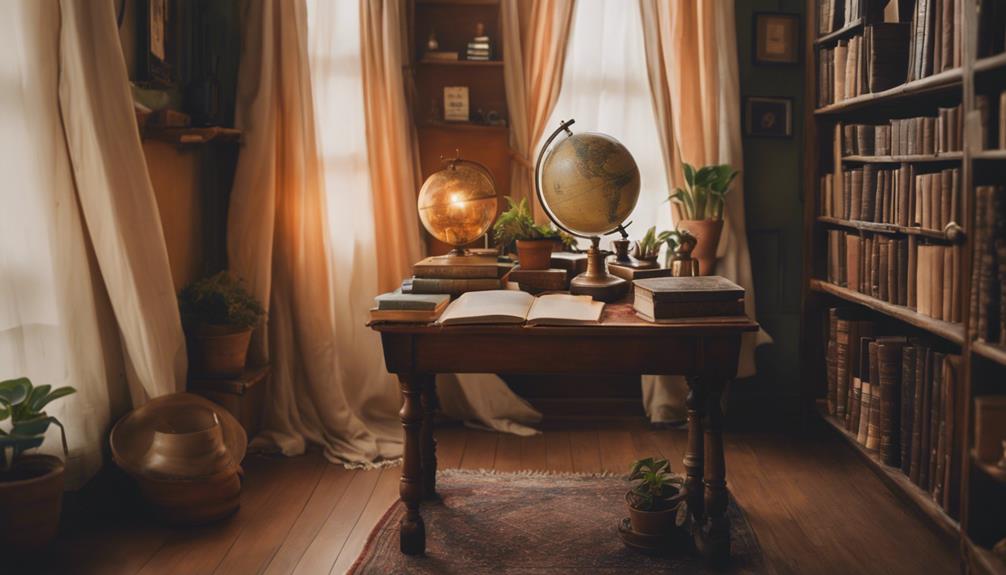
To elevate your light academia aesthetic, think about incorporating framed botanical prints to bring nature indoors.
An antique porcelain tea set can add a touch of elegance, while vintage leather-bound journals invite you to capture your thoughts and ideas.
These decorative elements not only enhance the room's charm but also reflect your appreciation for beauty and intellect.
Framed Botanical Prints
Framed botanical prints enrich your Light Academia decor by adding a touch of nature's beauty with their delicate designs and soothing colors. These prints seamlessly blend with the aesthetic, reflecting a love for nature and art that complements your scholarly pursuits.
Sourcing framed botanical prints from vintage shops or online marketplaces allows you to curate a collection that feels both unique and personal.
Consider arranging these prints in a gallery wall format to create an inviting focal point in your space. This arrangement not only adds visual interest but also enhances the overall depth of your wall decor. Opting for antique or ornate frames elevates the elegance of the prints, aligning perfectly with the vintage charm that defines Light Academia.
Incorporating these botanical prints alongside other decorative elements, like antique books and vintage globes, promotes a tranquil and inspiring atmosphere. Each piece of art pays homage to the beauty of nature, encouraging you to reflect on your surroundings while immersing yourself in your studies.
Embrace the calming essence of framed botanical prints, and watch your Light Academia decor transform into a serene sanctuary.
Antique Porcelain Tea Set
Incorporating an antique porcelain tea set into your Light Academia decor instantly elevates the room's sophistication and charm. This quintessential decorative element embodies vintage charm and showcases your appreciation for classical elegance. Typically adorned with intricate floral patterns and delicate gilding, each piece serves both functional and aesthetic purposes.
Display your antique porcelain tea set on a wooden side table or within a glass cabinet to create a focal point that draws attention. This arrangement not only beautifies your space but also invites conversations about art, history, and culture. You can collect different pieces like teacups, teapots, and saucers, allowing for a personalized display that reflects your individual tastes and scholarly pursuits.
When you incorporate this tea set into gatherings or tea parties, it evokes a sense of nostalgia, creating an inviting atmosphere for warmth and intellectual discussion among your guests. Whether it's a quiet afternoon with a good book or a lively chat with friends, an antique porcelain tea set enhances the experience, making it memorable and enriching.
Vintage Leather-Bound Journals
Antique porcelain tea sets and vintage leather-bound journals both reflect the sophistication of Light Academia decor, each adding a unique touch that inspires creativity and intellectual exploration.
Vintage leather-bound journals serve as elegant decorative elements, embodying charm and nostalgia. Their intricate embossing and high-quality paper invite you to ponder the thoughts and musings they may contain.
You can display these journals on bookshelves or coffee tables, enhancing the scholarly vibe of your space. The rich textures and muted tones of leather-bound journals seamlessly blend with the soft color palette typical of Light Academia, creating an inviting atmosphere.
Not only do they serve as decor, but they also encourage learning and self-discovery through writing or sketching, aligning perfectly with the aesthetic's values.
Consider collecting a variety of vintage journals to showcase your individual interests in literature and art. This personal touch adds depth to your decor while reflecting your creativity.
Flooring

When it comes to flooring in your light academia space, light oak hardwood creates a warm and inviting foundation.
Pair it with a cream-colored area rug to soften the look and add comfort underfoot.
If you're aiming for a more rustic vibe, consider distressed whitewashed pine flooring for that charming, vintage touch.
Light Oak Hardwood Flooring
Light oak hardwood flooring enhances the airy ambiance of light academia spaces with its neutral tone and natural grain patterns. This flooring option creates an airy and bright atmosphere, making it perfect for your light academia-themed spaces. The subtle warmth of light oak complements your decor, adding a vintage touch that aligns beautifully with the scholarly aesthetic.
Durability is another advantage of light oak hardwood flooring. It's easy to maintain, making it a practical choice for high-traffic areas while still conveying an elegant vibe. Whether you choose a matte or satin finish, this flooring maintains a classic appearance that works harmoniously with your decor.
Its versatility allows you to pair it with various color palettes, especially soft pastels and neutral shades that are essential to light academia decor. This interaction between the flooring and your chosen colors enhances the overall aesthetic, creating a cohesive look that wows everyone who enters the room.
When you invest in light oak hardwood flooring, you're not just choosing a surface; you're creating a foundation for a beautiful and inspiring space that reflects your love for literature and learning.
Cream-Colored Area Rug
A cream-colored area rug can effortlessly anchor your light academia decor, providing a warm and inviting foundation that enhances the overall aesthetic. Its soft tone brightens the room, allowing natural light to flow and creating a cozy atmosphere for relaxation and scholarly pursuits. By integrating a cream-colored area rug into your space, you'll find it complements the neutral color palette characteristic of light academia.
When selecting a rug, consider opting for a textured one made from wool or cotton, as this can add depth and comfort, perfect for your cozy reading nooks or study areas. The rug will also act as a cohesive backdrop for your decor, seamlessly tying together vintage furniture pieces and botanical prints that reflect the light academia aesthetic.
To further enhance the charm of your room, look for patterns like subtle florals or classic motifs. These designs resonate with the vintage influences of the style while maintaining a sophisticated look.
Ultimately, a cream-colored area rug not only elevates your decor but also provides a versatile base for your light academia sanctuary.
Distressed Whitewashed Pine Flooring
Integrating distressed whitewashed pine flooring into your light academia decor enhances the room's airy and inviting atmosphere while perfectly complementing the cream-colored area rug. This flooring embodies the light academia aesthetic with its soft, neutral tones that create a bright and uplifting environment.
The light color effectively reflects natural light, contributing to a warm and inviting ambiance essential for a scholarly space. The rustic charm of distressed finishes highlights the natural grain of the wood, adding character that resonates with vintage and antique decor. This combination fosters a lived-in feel, making your room not just visually appealing but also comforting and inspiring.
Moreover, distressed whitewashed pine flooring is a durable and sustainable choice, aligning with the eco-friendly principles often found in light academia settings. Its ability to withstand the test of time mirrors the romanticized, intellectual lifestyle you aspire to embody.
Can Dark Academia Room Decor also give a scholarly and aesthetic look like Light Academia Room Decor?
Yes, dark academia decor scholarly aesthetic can also give a scholarly and aesthetic look like light academia room decor. With its classic, vintage, and intellectual appeal, dark academia decor is perfect for creating a cozy and sophisticated study space. Rich colors, antique furniture, and timeless literature all contribute to the scholarly aesthetic of dark academia room decor.
Conclusion
Incorporating light academia decor into your space can truly transform it into a bright and scholarly haven.
By focusing on key elements like essential fixtures, thoughtful lighting, and charming decorative touches, you'll create an inviting atmosphere that impresses everyone who enters.
Don't forget to choose flooring that complements your aesthetic, tying the whole look together.
So go ahead, embrace this enchanting style and let your room reflect a love for knowledge and beauty!
